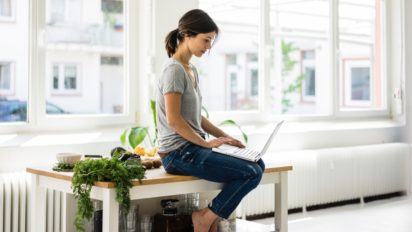Another school year has started, which means the student in your home will need access to the internet to attend classes, do research, email homework and more.
With the average internet bill running around $90/mo., it’s a costly but necessary utility. So, how can you get free internet for the school year?
Free government internet programs
The best option for free internet is to apply for the federal government’s Affordable Connectivity Plan (ACP).
The program provides a discount of up to $30/mo. and up to $75/mo. for households on qualifying Tribal lands. It also provides a one-time $100 discount toward a laptop, desktop computer or tablet. The ACP partners with internet service providers which offer $30 and under plans with a minimum of 100 Mbps download speed – enough for a family of four to video conference, stream videos and do homework.
Your household is eligible if you have an income at or below 200% of federal poverty guidelines.
OR if any member of your household:
- Qualifies for certain assistance programs, such as Medicaid, SNAP, federal public housing assistance, WIC or Lifeline. If you are already enrolled in Lifeline, you automatically qualify for ACP.
- Receives benefits under the free and reduced-price school lunch program or the school breakfast program, including through the USDA Community Eligibility Provision.
- Received a Federal Pell Grant during the current award year.
- Participates in Tribal specific programs, such as Bureau of Indian Affairs General Assistance, Tribal TANF, or Food Distribution Program on Indian Reservations (FDPIR).
Some providers have their own low-income programs, most of which require you to first qualify for the ACP.
For example, AT&T offers the Access program. For those approved through the ACP, benefits include free installation, free in-home Wi-Fi®, no annual contract, unlimited data and no deposit. The ACP covers the monthly fee of up to $30/mo., but not installation so this extra program will handle those costs.
Verizon’s free plan is Verizon Forward, which offers an internet plan of 300 Mbps, normally $49.99/mo., but with ACP covering $30 and Verizon Forward picking up the rest, your plan is free.
Using a hotspot for free internet
A hotspot can route your cellphone’s internet data connection to your laptop or other device. Unless you have a separate plan for that hotspot, it can get expensive to access, especially if you have a student using it for hours of homework and classes.
Provider hotspots
Some providers offer free or discounted hotspot plans. That’s where T-Mobile has stepped in with their Project 10 Million, which provides free internet and mobile hotspots to eligible households.
T-Mobile’s video walks you through the application process:
Public hotspots
If you don’t qualify for one of the available programs, public Wi-Fi hotspots are always an option. It does come with some privacy and security risks. If you have access to a school or library’s Wi-Fi network that requires a password, they would be the best to use.
If you need to use a more public place like open Wi-Fi in a coffee shop or restaurant, be aware that your device and your personal information can be at risk. Consider using a VPN, firewalls or antivirus software on your laptop to ensure your data remains private.
Wrapping up
If you need free internet for this school year, check out the ACP or use your address to find local ISPs and explore their free or low-income programs.
Your other option is to use hotspots or call your child’s school to see if they provide open hours for Wi-Fi use.
If you’re a college student, there are off-campus internet options available to you. There are also student and teacher tech discount programs to consider as well.
Check out Allconnect’s Research Hub and News Hub for more broadband information.
Allconnect: Let us compare providers for you
Why should you choose Allconnect? We’re the #1 broadband marketplace in the U.S, meaning you can trust us to search, compare and order internet and TV service for your home.
Get started
Written by:
Robin LaytonEditor, Broadband Content
Robin Layton is an editor for the broadband marketplace Allconnect. She built her internet industry expertise writing and editing for four years on the site, as well as on Allconnect’s sister site MYMOVE.com. …
Read more

Edited by:
Camryn Smith-
Featured
![A guide to internet resources for Native Americans]() A guide to internet resources for Native Americans Camryn Smith — 4 min read
A guide to internet resources for Native Americans Camryn Smith — 4 min read -
Featured
![Digital Divide – Resources for parents to help their children learn online]() Digital Divide – Resources for parents to help their children learn online Ari Howard — 3 min read
Digital Divide – Resources for parents to help their children learn online Ari Howard — 3 min read -
Featured
![Free and low-income internet options]() Free and low-income internet options Robin Layton — 5 min read
Free and low-income internet options Robin Layton — 5 min read
Latest
-
Wednesday, October 23, 2024
What is my IP address and why does it matter?Camryn Smith — 3 min read
-
Tuesday, October 22, 2024
Everything you need to know about internet speedsRobin Layton — 5 min read
-
Tuesday, October 22, 2024
How to change your Wi-Fi network passwordCamryn Smith — 3 min read






